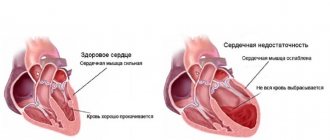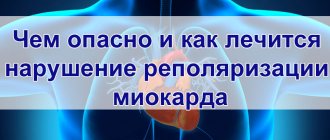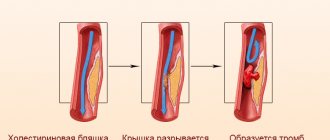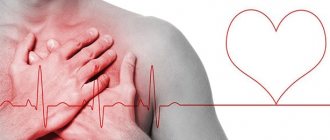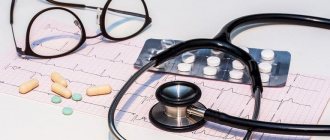Cardiac dysfunction occurs after a heart attack, as a result of a long course of arterial hypertension, congenital or acquired malformations of the heart and blood vessels.
In the early stages, it manifests itself sparingly and does not give the patient any reason to worry or see a doctor. As heart failure progresses, the clinical picture is complicated by stagnation of blood in the venous bed.
Objectively, this is manifested by swelling of the legs: the legs at the level of the ankles are the first to suffer, then the process rises higher.
This is a specific sign of heart failure, but the symptom also occurs against the background of noncardiac pathologies. For example, varicose veins, thrombosis, renal failure and others.
Effective differentiation is possible only in the early stages, since cardiac dysfunction will certainly lead to multiple organ failure. This means that the kidneys and liver will be involved in the process.
The swelling will become mixed, and accurate diagnosis will be difficult and time-consuming.
Mechanism of occurrence
The disorder is based on changes in speed and efficiency of blood flow in the large and small circles.
The result of a decrease in myocardial contractility is a slow movement of connective tissue.
Stagnation in the veins leads to an increase in pressure and the release of the liquid fraction, plasma, into the intercellular space.
At its core, edema is an increase in the volume of soft tissue for a specified reason. Since the force of gravity acts strictly vertically, from top to bottom, the legs are the first to suffer.
As the pathological process progresses, the condition worsens, but this takes time. On average, the development of a complex disease takes from 2 to 6-7 years.
Peripheral edema also forms as a result of the further development of secondary pathological processes. Like kidney failure, liver dysfunction.
It is problematic to distinguish conditions from each other, especially in the later stages of cardiac decompensation.
The intensity of the symptom becomes higher, which indicates continued progression. Diagnostic measures, multiple ones, put an end to the question.
The difference between cardiac edema and others
Typical features of a cardiac symptom are:
- Complete absence of painful manifestations during palpation, walking and any physical activity or manual influence.
Against the background of thrombosis or varicose veins, the discomfort is pronounced and intensifies after any activity and pressure on the affected area. This is a reliable sign for distinguishing between the two conditions.
- Symmetry and corresponding swelling are immediately visible on both sides. This practically never happens with thrombosis; the symptom rarely occurs against the background of varicose veins. Typically, one leg is affected.
- Edema of cardiac origin appears in the evening. Usually after prolonged exercise, of which even simple walking and climbing stairs are considered in a state of insufficiency.
Renal dysfunction is manifested by morning edema. During daylight hours, excess fluid due to pathologies of the cardiovascular system subsides and completely disappears.
Disorders with thrombosis and varicose veins occur suddenly. Usually associated with physical activity.
- Cyanosis of the dermis of the affected limbs. A bluish tint to the skin at the site of edema due to heart disease. In other cases it is pale (kidney problems), red, etc. This is a characteristic differential feature.
- Tendency to deformation. When pressing on the affected area, a clearly visible white dent remains, which is gradually eliminated.
Against the background of renal pathologies, the degree of deformation is less. And varicose veins or thrombosis are characterized by an increase in tissue density. They feel hard and stone to the touch. Not palpable.
The basis of differential diagnosis is not the above points, but the accompanying manifestations.
The clinical picture differs in all cases, therefore it is necessary to evaluate it first, and other routine issues are considered as part of confirming the hypotheses.
In any case, it is impossible to do without auxiliary research.
Manifestation of edema
Due to the fact that during a heart attack the patient feels severe pain, he cannot distinguish between other pathological symptoms that are a signal of complications. Signs of infarction pulmonary edema develop rapidly and can appear both during the attack and a few days after it. The pathology may occur once or may develop periodically. The main signs of edema are:
- manifestation of wheezing (first dry, then wet) due to blood entering the lungs;
- temperature increase;
- weakness;
- feeling of pain in the chest and heart;
- development of tachycardia;
- respiratory dysfunction;
- change in skin color (becomes bluish);
- swelling of the veins in the neck;
- appearance of nervousness.
Read also: Life expectancy after myocardial infarction
The air that passes through the accumulated liquid tends to foam under such conditions. This process completely blocks the airways, causing suffocation.
Additional symptoms
Cardiac edema of the legs has a lot of accompanying symptoms. Their development is caused by cardiac failure itself.
At the first stage
Everything can be limited to the following phenomena:
- Slight shortness of breath. After intense physical activity. The average person is not active enough to notice a deviation from the norm. In athletes and physical workers, the symptom is immediately noticeable.
- Unexplained weakness, fatigue. Asthenic manifestations against the background of other relative well-being. The patient is lethargic and drowsy. The feeling of well-being is attributed to lack of sleep or overwork.
- Minor rhythm deviations like sinus tachycardia. The heart is still active, so the body tries to correct the lack of nutrition by increasing the frequency of contractions. This does not give an effect; as the rhythm progresses, the rhythm shifts more and more toward a slower rate until it reaches a critical point.
Second stage
From about the second stage of the disease, the clinical picture takes on complete features. The manifestations are cardiac; other organs and systems are not yet involved.
Among the typical points:
- Chest pain of unknown origin. The patient does not always connect discomfort with cardiac problems, and therefore does not consult a doctor immediately. The episodes are short-lived. Lasts no more than a few minutes, or even seconds. The nature of the syndrome is pressing or burning; the disorder occurs regularly.
- Arrhythmia type bradycardia. Reduction of heart rate to a level of 60 beats and below. At the same time, in athletes and manual workers, the symptom as such is absent until the condition is completely decompensated.
Recovery is carried out with special drugs. In addition to bradycardia, other forms can be added, including extrasystole (the occurrence of extraordinary beats between contractions), fibrillation (chaotic work of the entire heart).
This is a factor in the development of early death. Without treatment, death cannot be avoided. The cause is cardiac arrest.
- Dyspnea. Against a background of complete peace. Later, even minimal physical activity becomes impossible. A trip to the store or a light walk is a big challenge for the core. At the subcompensation stage, things are usually not so bad; there are limitations, but not critical. The process is characterized as a decrease in tolerance to mechanical stress.
- Headache. Localized in the back of the head. It occurs as a result of alternating changes in vascular tone. Usually due to a drop in blood pressure - hypotension.
- Virtigo. Disorientation in space. The patient cannot walk or even stand normally. The world is going round and round. The symptom is nonspecific and indicates damage to the cerebral structures of the ischemic plan. Simply put, blood flow is weakened, and nerve tissues do not receive enough nutrients.
- Loss of consciousness. Fainting condition. The correction is urgent. This is a negative prognostic sign; it indicates a weakening of brain nutrition and increases the risk of stroke and acute disturbance of cerebral blood flow.
Peripheral swelling intensifies and covers all lower extremities from the groin to the foot. It is persistent and difficult to stop with improvised means.
Changing body position does not help, because the reason is a decrease in the pumping function of the heart.
Expressed stage
Gives a lot of manifestations in addition to cardiac ones.
- Increased liver size. Outcome of induced secondary hepatitis. Inflammation of the organ. Accompanied by pain, detected by palpation of the right hypochondrium.
- Yellowing of the sclera of the eyes and skin. As a result of the release of bilirubin into the bloodstream.
- Ascites. Accumulation of fluid in the abdomen and an increase in its size. A specific sign of liver pathologies.
- Lower back pain, decreased daily urine volume. The so-called oliguria. Accompanies kidney failure. Recovery is very difficult.
Swelling due to dysfunction of the excretory system is pronounced. It is difficult to distinguish them from those in cardiac pathologies.
Swelling in the legs due to heart failure is well differentiated from others by primary signs only in the early stages. Then the matter is complicated by other symptoms and multiple etiologies.
Relieving swelling after a heart attack
Leg swelling is one of the common complications of large-focal myocardial infarction. Fluid first accumulates in the area of the feet and legs. As heart failure progresses, swelling may spread to the thighs and abdomen. The extreme degree of swelling is called anasarca. In this case, ascites (fluid in the abdominal cavity), hydrothorax (fluid in the pleural cavity near the lungs) and liver enlargement are usually associated. All these signs are characteristic of blood stagnation in the systemic circulation.
Causes of edema after a heart attack
The main causes of edema after myocardial infarction include:
- Decreased cardiac output;
- Increased intravascular fluid volume;
- Increased vascular resistance;
- Violation of venous outflow.
With the development of any edema, the leading role is played by an imbalance between filtration and absorption of intravascular fluid through the capillary wall. After a myocardial infarction, the body undergoes serious changes. This occurs not only due to a purely mechanical deterioration in the pumping function of the blood, but also due to the production of certain hormones that are responsible for kidney function. It turns out that the “motor” works with less intensity for a larger volume of liquid. As a result of this discrepancy, edema develops.
Treatment of edema after a heart attack
Like many other diseases, swelling after a heart attack is easier to prevent than to treat later. Therefore, when the patient is discharged, the doctor gives strict recommendations regarding further lifestyle.
The right lifestyle against edema
Firstly, the recommendations relate to the drinking regime
. A person who has suffered a large-focal myocardial infarction should not drink more than a liter of water per day. In especially severe cases, it is necessary to monitor the entire volume of fluid consumed and compare it with the volume of urine excreted. These figures should be approximately the same. An easier way to track fluid accumulation in the body is to weigh yourself daily on an empty stomach and keep a diary.
Secondly, it is necessary to exclude
salty
and spicy
foods
from the diet . The sodium contained in salt leads to disruption of the kidneys, and as a result, the accumulation of fluid in the tissues.
And thirdly, we need to fight physical inactivity
. that is, perform moderate exercise. After a heart attack, it's mostly leisurely walks in the park. As a result of the work of the leg muscles, venous outflow from the lower extremities improves and the likelihood of developing edema is reduced.
Medicines for the treatment of edema
The largest group used for edema after myocardial infarction is diuretics
facilities. It should be remembered that a large amount of microelements, in particular potassium and magnesium, are excreted from the body along with urine, so additional intake of panangin or its substitute is very important.
Almost all patients after myocardial infarction are prescribed inhibitors
angiotensin converting enzyme (ACE). Drugs in this group not only normalize blood pressure, but also restore the disturbed balance of renal filtration.
There are other, less popular, classes of drugs to improve heart function and reduce swelling after a heart attack (beta blockers, digoxin). Do not forget that self-medication can be dangerous and before using medications, you should consult a cardiologist.
Diagnostics
It is carried out under the supervision of a cardiologist; depending on the stage of the process, the examination can be carried out in an inpatient or outpatient setting. The issue is resolved at the discretion of specialists.
Approximate list of events:
- Oral questioning of the patient. Allows you to objectify symptoms and create a clear clinical picture. Used as part of routine initial examination.
- Anamnesis collection. Briefly. What illness did the person have when? How long. Lifestyle, family history, and other points are also clarified. Both methods are basic. They are necessary to determine the vector of further actions.
- Auscultation, listening to heart sounds. If insufficiency, and, as a consequence, swelling of the legs occurs against the background of a defect in the cardiac structures, dull irregular tones and splitting are detected.
- Measurement of blood pressure and heart rate. The first indicator is consistently below the norm, because the symptoms of burning contractile function are increasing. Heart rate is first of the tachycardia type, that is, acceleration, then the reverse process.
- Daily monitoring. Usually prescribed as part of a comprehensive diagnosis. Records vital signs for 24 hours. Dynamic observation.
- Electrocardiography. Brings to the surface arrhythmias and possible defects. But decoding requires high-quality training of specialists.
- Echocardiography. Shows deviations of the anatomical plan.
Intramural myocardial infarction
Treatment of pulmonary edema during myocardial infarction begins with neuroleptanalgesia. Fentanyl (1 - 2 ml of 0.005% solution) and droperidol (2-4 ml of 2.5% solution) are injected intravenously. If this mixture is not available, 1 ml of 1% morphine solution (0.5 ml for old people) or promedol can be administered intravenously.
For pulmonary edema without pain, neurolepsy with droperidol (2.5% solution, 2-4 ml) is indicated intravenously. To destroy the foam, inhalation of oxygen with vapors of 20-50 degrees alcohol or a 10% alcohol solution of antifomsilane is used.
In case of normal or elevated blood pressure, Lasix (furosemide) is injected intravenously at a rate of 1 - 2.5 mg/kg. Immediately after administration, even before diuresis increases, its extrarenal effect manifests itself - a decrease in the volume of circulating blood in the lungs due to its redistribution.
Already at the prehospital stage, for cardiac asthma and incipient pulmonary edema, sublingual administration of nitroglycerin is recommended. It is given in 1 tablet. (0.5 mg) after 2 minutes 3-5 times with constant monitoring of blood pressure, not allowing a decrease of more than 30% from the original.
In a hospital setting, treatment of pulmonary edema begins with intravenous jet administration of 0.5-1.0 ml of a 1% solution of nitroglycerin dissolved in 20 ml of isotonic solution. In this case, careful monitoring of blood pressure is necessary and it is recommended not to reduce it by more than 30% of the original.
If pulmonary edema does not stop and blood pressure remains high, the administration of nitroglycerin can be repeated after 5-15 minutes at the same dose. The total dose of injected nitroglycerin should not exceed 5 ml (50 mg).
DETAILS: Idiopathic arrhythmia treatment -
In the future, if pulmonary edema still persists and blood pressure remains elevated, you can switch to intravenous drip administration of nitroglycerin at a dose of 6 ml of a 1% solution per 400 ml of isotonic solution at a rate of 8-10 drops per minute.
Instead of nitroglycerin, a ganglion blocker can be used (0.5 ml of a 5% solution of pentamine in 20 ml of a 40% glucose solution or isotonic sodium chloride solution or arfonad 50-150 mg intravenously).
Pentamine is injected very slowly into a vein (over 5-10 minutes). Blood pressure is measured every 3 minutes, interrupting the injection of pentamine. The injection of pentamine is completely stopped when the systolic pressure decreases to 110-120 mmHg. since the drop in pressure can continue for another 5-10 minutes after injection.
https://www.youtube.com/watch?v=8VzLRcUvPq4
The effect of pentamine is particularly rapid in pulmonary edema, which occurs with a significant increase in blood pressure. For example, a patient with a systolic pressure level of about 200 mm Hg.
the feeling of suffocation (as well as wet rales) may disappear within 15-20 minutes after an intravenous injection of pentamine. If the systolic pressure slightly exceeds the norm (about 150 mm Hg), then pulmonary edema, despite the administration of pentamine, lasts for 1/2-4 hours (M. SKushakovsky, 1990).
Another treatment option for infarction pulmonary edema, accompanied by a significant increase in blood pressure, is associated with the use of a peripheral vasodilator - sodium nitroprusside (nanipruss, nipride).
However, nitroglycerin relieves pulmonary edema more quickly, does not lower blood pressure as sharply as pentamine, and does not cause the “steal” syndrome like sodium nitroprusside.
For patients with normal blood pressure (systolic pressure above 100-110 mm Hg), treatment of pulmonary edema begins with intravenous drip infusion of nitroglycerin: 1 - 2 ml of 1% nitroglycerin solution is diluted in 200 ml of isotonic sodium chloride solution and administered at a rate of 20-30 cap/min through a catheter installed in a vein (constant monitoring of blood pressure levels!).
For pulmonary edema in patients with low blood pressure (systolic pressure below 100 mm Hg), pentamine, sodium nitroprusside, and nitroglycerin are contraindicated. There are no prerequisites for early prescription of diuretics.
Drugs for neuroleptanalgesia are still indicated. 90-150 mg of prednisolone is injected into a vein, a drip infusion of 0.25 ml of a 0.05% solution of strophanthin in 200 ml of rheopolyglucin is established. To this solution you can add 125 mg (5 ml) of hydrocortisone acetate (infusion rate 60 drops/min).
Dopamine 200 mg (5 ml of 4% solution) is injected intravenously into 400 ml of 5% glucose solution or isotonic sodium chloride solution (initial rate of intravenous infusion - 5 mcg/kg per minute), or 10 drops of 0.05% solution per minute .
Gradually the infusion rate is increased to 20 drops/min. At this rate of infusion, an increase in diuresis is observed. A subsequent increase in the infusion rate (30 drops/min) leads to an increase in diastolic pressure and increased heart rate.
At this point, it is better to pause or stop the dopamine infusion. Toxic doses of dopamine cause ventricular tachycardia. An increased level of blood pressure (90 mmHg and above) allows caution to carry out an intravenous drip infusion (through another dropper) of nitroglycerin (1 ml of a 1% solution in 200 ml of isotonic sodium chloride solution) at a rate of 20 drops/min.
Naturally, systematic monitoring of blood pressure levels is required: if blood pressure decreases, it is regulated by administering dopamine (not lower than 100-110 mm Hg). Against this background, 80-120 mg of Glasix is administered intravenously.
When pulmonary edema and cardiogenic shock are combined in patients with acute myocardial infarction, a combination of nitroglycerin and dopamine is also used, but the dose of dopamine is increased accordingly. Lasix (80-120 mg) is administered when it is possible to increase systolic blood pressure to at least 90 mmHg. A 4% solution of sodium bicarbonate 100-150 ml and prednisolone 90 mg are also administered.
The prognosis for pulmonary edema in combination with cardiogenic shock is extremely unfavorable. In other cases, it usually responds well to treatment.
A.A. Maptynov
Differentiation with pathologies of the excretory system
As part of differential diagnosis, the following studies are carried out:
- Ultrasound of the kidneys.
- Clinical urine analysis. Used to assess the filtering function of a paired organ. Against the background of deficiency, there are no or few salts, and the specific gravity is also significantly reduced.
- Ultrasound of the liver and abdominal organs.
- Scintigraphy of the structures of the excretory system.
- Dopplerography of the vessels of the lower extremities. To assess the speed of blood flow and the effectiveness of tissue trophism. Most often used for differential diagnosis.
In the later stages, the examination may take a long time. At least a week, maybe more. It is important not to delay and consult a doctor at the first deviation in your health.
Treatment
Therapy is carried out as part of a complex intervention. There is no point in removing only swelling, they themselves do not pose a danger. The threat comes from heart failure.
Elimination of the root cause is medicinal. Surgical intervention is required for the correction of defects: anatomical defects such as insufficiency of the tricuspid, aortic or mitral valves, and other conditions.
Main drugs and their groups:
- Cardiac glycosides. They enhance the contractility of the myocardium, adjust the volume of blood entering the systemic circulation, and restore tissue nutrition. Digoxin or lily of the valley tincture.
- Mild diuretics with an antagonistic effect on aldosterone. Spironolactone or Veroshpiron (analogues). Remove excess fluid and prevent vasospasm. Indirectly affect the concentration of angiotensin-II and renin.
- Beta blockers in the early stages to eliminate tachycardia. ACE inhibitors are prescribed for the same purpose.
Treatment of swelling of the legs as such or relief of the symptom is carried out with the help of diuretics. With intense manifestations, more active medications are used, such as Furosemide.
Surgical treatment, as stated, is carried out according to indications. If there is a heart defect, an anatomical defect of the vessel.
An approximate list of diseases includes: aneurysm of the wall of a muscular organ, aorta in any part, insufficiency of the tricuspid, mitral valves, septa, and others.
Preference is given to minimally invasive interventions, with endovascular access (through the femoral artery).
The pathological process that causes edema requires lifelong correction of habits, regardless of the stage of insufficiency.
The recommendations are simple, you need to follow the rules of common sense:
- Give up cigarettes, alcohol, especially drugs.
- Do not take medications unless prescribed by a specialist. Particularly dangerous or cardiotoxic are anti-inflammatory drugs of non-steroidal origin (the absolute record holder is Diclofenac, which has been repeatedly proven), oral contraceptives, antibiotics, antiparasitic medications and others.
- Sleep at least 7 hours during the night. Approximately a quarter of the period should occur before 22.00.
- Limit the amount of fat in your diet, consume less table salt (no more than 7 grams per day).
- Try not to sit in one place all the time. Physical inactivity only aggravates congestion in the body, including reducing the speed of blood flow.
If you have a tendency to varicose veins, the condition will get worse. You need to move, walking in the fresh air is suitable. You cannot overexert yourself, this is fraught with complications, including cardiac arrest.
- Drink 1.5-1.7 liters of water. More is excess load. Possibly less, depending on the general health of the person. According to indications, the volume is reduced.
It is also important to avoid stress. Master relaxation techniques and, if necessary, consult a psychotherapist to correct the status using non-drug methods or using light sedatives based on medicinal herbs.
Swelling of the legs due to heart failure should be treated under the supervision of a cardiologist. As part of extended therapy at advanced stages - a whole council of specialists.
Complications in the acute period
These are the most severe early consequences of myocardial infarction.
AHF of the left ventricular type develops quite often. Its severity depends on the size of the area of myocardial damage. Cardiogenic shock is considered a severe stage of acute heart failure and is characterized by a decrease in the pumping function of the heart as a result of tissue necrosis. Treatment consists of taking nitroglycerin, ACE inhibitors, cardiac glycosides, diuretics, beta-agonists, and vasopressors. Endovascular methods include coronary angioplasty and intra-aortic balloon counterpulsation. In severe cases, surgery is performed.
Occurs in the first five days from the onset of myocardial infarction. It occurs more often in women, older people, with hypertension, high heart rate, and with anterior heart attacks. Early surgical treatment is usually indicated; endovascular methods may be used. Vasodilators are prescribed as medications.
In most cases, mild or moderate mitral regurgitation develops after myocardial infarction. Usually it is transient. The severe form is life-threatening, caused by rupture of the papillary muscle, which usually occurs in the first day after the onset of a heart attack. This complication occurs most often with lower localization infarctions.
Mitral regurgitation is treated with medication. In severe cases caused by ischemia rather than rupture of the papillary muscle, coronary angioplasty is indicated. If the papillary muscle ruptures, urgent surgery is needed, otherwise we can talk about an unfavorable prognosis.
Happens only in the case of transmural myocardial infarction. 50% of ruptures occur in the first five days. Patients with a first heart attack, women, the elderly and those suffering from arterial hypertension are at increased risk. Urgent assistance is required in the form of surgical closure of the defect.
Thromboembolism of the systemic circulation usually occurs in the first ten days after the onset of a heart attack. As a rule, it is observed with infarctions of anterior localization. For large infarctions, slow intravenous administration of heparin is indicated on the first day, then anticoagulant therapy with warfarin is prescribed.
This inflammatory disease develops in 10% of patients in case of myocardial infarction during the first 1-4 days. Pericarditis develops most often with transmural infarction, when all three layers of the heart are affected. For pericarditis, taking aspirin 4 to 6 times a day is indicated.
Arrhythmias are the most common complication of early myocardial infarction, observed in approximately 90% of patients. Typically, left ventricular fibrillation and paroxysmal left ventricular atrial fibrillation develop. Arrhythmias after a heart attack can be life-threatening, so emergency medical attention is needed.
As a rule, it occurs with a transmural infarction, but it can also occur with small tissue lesions. It develops most often in the first week from the onset of the disease. Its cause is acute heart failure. Pulmonary edema requires urgent help. The patient is administered diuretics and glycosides intravenously.
It develops, as a rule, in the case of transmural myocardial infarction localized at the apex of the left ventricle. Acute aneurysm is fraught with severe heart failure and shock. Vasodilators are prescribed intravenously, ACE inhibitors, and intra-aortic balloon counterpulsation. In case of persistent heart failure and rhythm disturbances, surgical treatment is possible.
Late complications of myocardial infarction appear 3-4 weeks after the onset of the disease. The most common consequences of this period are chronic arrhythmias and chronic heart failure.
With post-infarction syndrome, the pleura, pericardium, and lungs become simultaneously inflamed. It happens that only one pathology develops, most often it is pericarditis, which can be accompanied by pleurisy and pneumonitis. This syndrome occurs as an immunological reaction of the body to tissue necrosis. Hormonal treatment is indicated.
It is believed that the disease has an autoimmune mechanism of development. Occurs between 1 and 8 weeks after the onset of myocardial infarction. Aspirin is initially indicated, then glucocorticoids can be prescribed.
Develops after transmural myocardial infarction. Characterized by the formation of blood clots on the walls of the heart chambers.
With this complication, the heart is not able to pump blood in the required volume, and therefore supply tissues and organs with oxygen. Characteristic signs are shortness of breath and swelling. You need to lead a healthy lifestyle, get rid of bad habits, and monitor your blood pressure. Typically, beta blockers are prescribed to reduce the oxygen demand of the heart muscle.
A chronic aneurysm forms 1.5 to 2 months after the onset of myocardial infarction. By this time, it is completely scarred, interferes with the functioning of the heart, and contributes to the development of heart failure. Drug treatment is indicated. In some cases, surgical intervention is necessary, in which the aneurysm is excised and the heart muscle defect is sutured.
It develops as a result of the replacement of myocardial tissue lost during a heart attack with coarse connective tissue. This diagnosis is made 2-4 months after the onset of a heart attack. As a result of the formation of scar areas, the contractile function of the heart deteriorates, which leads to disturbances in heart rhythm and conduction, as well as to the development of heart failure.
After myocardial infarction, complications from the genitourinary system and gastrointestinal tract, mental disorders (psychosis, depression) cannot be excluded.
